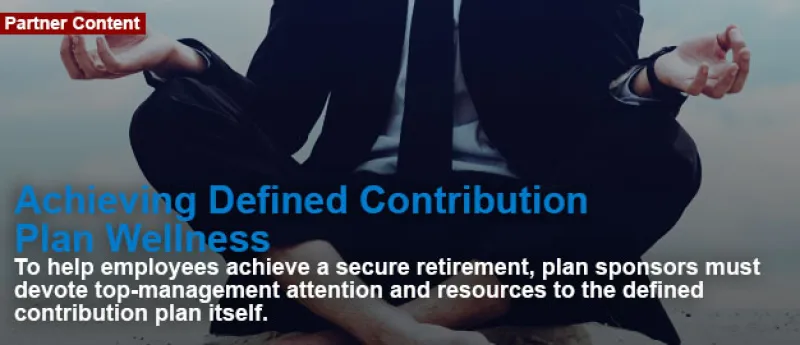The American way of providing for retirement is changing, driven by longer life spans, lifestyle choices, uncertainty about the future of Social Security and the transition by employers from defined benefit to defined contribution plans. These changes place the responsibility to provide for retirement more and more firmly on the shoulders of employees. According to a 2015 study, three out of four Americans with jobs do not expect to live as well as their parents did in retirement, about one out of three worry their savings will run out 15 years into retirement and half think their money will be gone within 25 years.1 In another recent survey, 83 percent of respondents say they worry about their lack of overall savings while 69 percent express concern about their ability to retire at all.2
“We've seen a big transition over the last few years in all employee benefits. We're imposing more and more responsibility on employees, and that's a big transition and challenge for most employers and certainly their employees,” says Robyn Credico, defined contribution consulting leader at Willis Towers Watson. “We're asking these people to make decisions about how much to save, not only in their retirement plans but in their health care plans, how to invest and when to take out their money. That's a huge challenge for most people, no matter how educated you are.”
If the new defined contribution-based system is to help employees achieve a secure retirement, plan sponsors will have to apply management attention and resources to the plan itself. “If you're going to focus on financial wellness at the participant level, you've got to deliver a defined contribution plan that has all the right features to help them at the institutional level,” says Clint Barker, senior vice president of Retirement Investment Solutions at Prudential investments. “How can you solve the individual piece if the primary savings vehicle is either poorly designed or inefficient?” Plan wellness has three distinct aspects, Barker says:
1. Industry wellness. Maintaining awareness of the impact of regulation on the features of the plan, avoiding litigation risk and making sure the plan partners with providers that offer solutions that help it achieve its objectives.
2. Plan design wellness. Adopting and optimizing plan features such as automatic enrollment, auto-escalation and a company match such that the plan encourages maximum participation and drives good saving behavior.
3. Investment wellness. Creating the right menu of investment choices and default options that direct employees’ investing behavior and provide good value at a reasonable cost.
Automatic enrollment and other “nudges” are becoming critical design components for plan sponsors looking to achieve plan wellness. Institutional Investor's recent study of over 500 sponsors of DC plans with assets of $50 million above, in partnership with Prudential, found that more than three out of five incorporate auto-enrollment today and 92 percent expect to in the next three years. Auto-escalation, too, is on the way to becoming a standard plan feature; 88 percent either offer it today or expect to in the next three years.
International Paper, which sponsors a $5 billion 401(k) plan, puts considerable resources into its basic communication and education efforts, including quarterly and annual newsletters, online access and on-site seminars. But “none of it is nearly as effective as the features of auto-enrollment, auto-escalation and auto-default,” says Bob Hunkeler, vice president of investments. “Inertia is a powerful force. We all know that it exists in our 401(k) plans and with our participants. We used to let inertia work against us, and now we're letting inertia work for us through these auto programs.”
At the same time, new technology for delivering information and even advice online, coupled with greater capability to understand employee saving behavior, create new opportunities to make communication and education more effective. “We still believe that there's this opportunity for individual, one-on-one financial wellness, coaching, guidance and advice, and it's really about delivering it in the way that the individual wants to receive it,” says Michael Domingos, vice president, Corporate Distribution and Strategy at Prudential Retirement.
Financial wellness programs, designed to educate and encourage employees to help them address their own conflicting financial priorities as well as put an effective plan for retirement saving in place, have strong support from plan sponsors, advisers and consultants. “Retirement planning is just one component of the overall financial picture. It’s different for everybody,” says Amy Labanowski, partner and senior investment consultant at Mercer. “People have different needs in different stages of their life cycle. They have conflicting or competing priorities in managing their finances. Having a more holistic approach of providing tools such as budgeting, paying off debt and including retirement as one piece of that can really help a participant tailor their plan for their individual circumstances.”
That means providing information that ties together as much of the employee’s total financial picture as possible and distilling it into a projection of his or her retirement outcome. “Trying to convince someone to do something that's in their best interest is a difficult task,” says Donna Wimbec, senior manager of global benefits compliance at Brown-Forman Corp., which sponsors corporate and union plans with a collective $448 million in assets as of July 2016. “What we try to do is give them information in a couple of different ways. If they have any balance at all in the 401(k) plan and in our savings plan, whenever they log in they will see that balance and how that benchmarks with where they should be as far as an 80% replacement income, projected to retirement. We tie that in with their pension plan, so that they really do get a full picture, and it also has Social Security mixed in with it.”
When employees achieve greater financial wellness and retirement security, the plan sponsor benefits as well. “Increases in productivity are to be gained from a true financial wellness program,” says Domingos. “Next is controlling costs—there are ways that this will actually help the employer control costs associated with the benefit and, more broadly, their business as well.”
“I would encourage them to start early,” Credico advises, “because if you've turned 65, it's probably much too late to change your behavior.”
1 Willis Towers Watson, Global Benefit Attitudes Survey, 2015-16..
2 Pew Charitable Trusts Issue Brief: Americans’ Financial Security—Perception and Reality, March 2015.
Auto Enrollment: An automatic contribution arrangement that can be used as a feature in a retirement plan to allow employers to enroll employees in the company’s plan automatically upon meeting eligibility requirements.
Auto Escalation: A plan design option that allows a plan sponsor to increase participant deferrals annually by a set increment.
© 2016 Prudential Financial, Inc. and its related entities. Prudential, and the Prudential logo, the Rock symbol and Bring Your Challenges are service marks of Prudential Financial, Inc., and its related entities, registered in many jurisdictions worldwide.
0298889-00001-00





